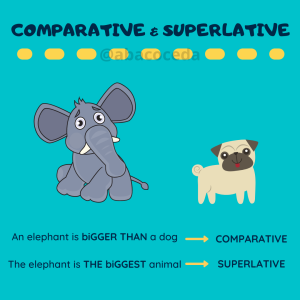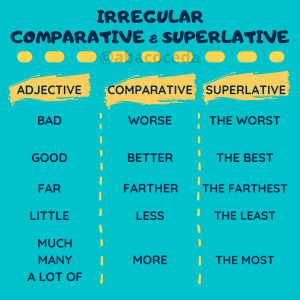Comparatives and Superlatives
COMPARATIVE and SUPERLATIVE
 Los adjetivos en inglés como en español tienen tres grados: positivo, comparativo y superlativo.
Los adjetivos en inglés como en español tienen tres grados: positivo, comparativo y superlativo.
En este post, os vamos a explicar de forma breve como se forma tanto el comparativo como superlativo en inglés.
A)COMPARATIVE
El comparativo puede ser de tres tipos: igualdad ( equality), inferioridad ( inferiority) y superioridad ( superiority).
1.Equality ( tan … como…)
Se forma: (NOT) AS + ADJECTIVE + AS
En este caso, no se diferencia entre adjetivos largos y cortos.
Examples:
Soy tan alto como tú : I am AS TALL AS you
El coche no es tan caro como la moto: The car is NOT AS EXPENSIVE AS the motorbike
2. Inferiority ( menos …. que…)
Se forma: LESS + ADJECTIVE + THAN
Examples:
Ana es menos alta que tú : Ana is less tall than you
3.Superiority ( más que…)
- Short adjectives: ADJECTIVE + er + THAN
Examples:
Él es más alto que Gasol: He is taller than Gasol
El tiempo en España es más caluroso que en Inglaterra: The weather in Spain is hotter than in England.
- Long adjectives: MORE + ADJECTIVE + THAN
Examples:
Este examen es más difícil que el ultimo: This exam is more difficult than the last one.
Mi hermana es más inteligente que él: My sister is more intelligent than him.
B) SUPERLATIVE ( el/ la más…)
a. Short adjectives: THE + ADJECTIVE + est + (NOUN) + (IN /OF)
Example:
Es el niño más alto e la clase: It is the tallest boy in the class
b.Long adjectives: THE MOST + ADJECTIVE + (NOUN)+ (IN /OF)
Example:
Este es el examen más difícil que yo haya hecho: This is the most difficult exam I ´ve ever done
-The article “ THE” normally appears before the superlative form.
-The superlative form can be followed by a complement introduced by:
IN → When we refer to a PLACE
OF → in the rest of cases.
IRREGULAR FORMS:
Por último, os dejamos algunos links para que practiquéis:

